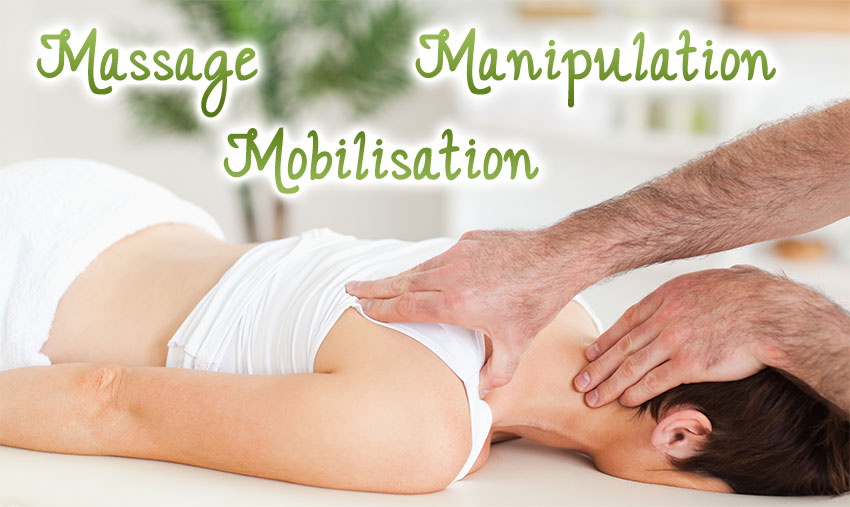Manual Therapy: Why we Rub, Poke and Prod you…

Manual Therapy (MT) is a physical treatment used by various clinicians to treat musculoskeletal pain and disability. It primarily takes the form of massage, joint mobilisation and joint manipulation. As sports injury specialists, we describe MT as a hands-on approach utilising specific techniques to treat joint structures and soft tissues (such as ligaments, joint capsules and muscles) with the purpose of reducing pain, increasing joint range of motion (ROM) (Threlkeld, 1992), facilitating movement and therefore improving joint and muscle function.
Massage, Mobilisation and Manipulation
As stated, the three most distinguished forms of MT are massage, mobilisation and manipulation. Massage refers to the manipulation of superficial and deeper layers of muscle and connective tissue; it typically involves the repetitive rubbing and kneading of these soft tissues to principally improve muscle tone. Mobilisations are characterised by a low velocity passive movement (Di Fabio, 1986) applied to a joint aiming to reduce pain and/or increase mobility; they are performed as oscillatory movements of varying amplitude or as sustained stretches. Manipulation, similar to mobilisation, again is regarded as a passive movement applied to a joint but in this instance the joint is taken to its end range and a short, sharp thrust is applied. Manipulations are often associated with an audible popping or cracking sound.
MT is essential in reducing your pain and improving your function
At City Rehab we pride ourselves on the use of MT; along with accurate injury diagnosis, appropriate injury education and exercise prescription and we achieve excellent results with our patients. But why do we value this hands-on approach so significantly and how does it work? Very often massage and mobilisation forms the foundation of our treatments, particularly in the early stages of your injury. Our initial intention is to reduce your pain and improve your function; we believe MT is essential to do this.
Massage is believed to have a number of physiological effects. With regards to treating patients, we use a multitude of massage techniques including effleurage, petrissage, and deep tissue massage to predominantly bring about a reduction in muscle soreness and tone. We also usea range of aggressive techniques such as soft tissue mobilisations, active release techniques, deep frictions and myofacial release to soften fascia, separate adhered tissues, breakdown scar tissue and reduce trigger point activity (Moraska, 2005). This in turn aids your recovery by allowing the muscles and their surrounding structures to work in a more effective manner and promote efficient movement patterns.
Joint mobilisation is primarily used to reduce pain and stiffness and works as a result of stimulation of joint mechanoreceptors. It is this stimulation that is believed to have the effect of reducing the perception of pain. It is not precisely known how this is achieved but it is thought that the passive movement applied to the joint bombards the Central Nervous System with movement signals which then block out the pain signals, a theory known as the ‘Pain-gate theory’. Additionally, the gliding of joint surfaces causes movement of the joint capsule which can decrease the joints’visco-elastic properties and mechanical resistance, i.e. stiffness (Crow et al., 2008). Again, a reduction in pain and stiffness will allow improved function.
Joint manipulations are something we use if it is felt that the patient would benefit from this type of treatment. It is believed that the high velocity thrust corrects joint position, realigns vertebral segments (Twomey, 1992), releases any soft tissue abnormalities such as spasm and can correct any muscle imbalance that may be present. The ‘pop’ or ‘crack’ that can sometimes be felt/heard as a result of this MT technique is a topic for debate but it is thought that the noise comes from gas bubbles that form in the joints as a consequence of negative pressure. The ‘crack’ isn’t always necessary but many therapists feel they get better results if cracks are heard, this however may be a psychological benefit.
Here at City Rehab, we highly value the use of MT to treat our patients; in combination with other rehabilitative strategies we gain excellent results. Through the use of a range of soft tissue release techniques including massage, joint mobilisation and occasionally joint manipulation we are able to reduce your pain, increase joint mobility, improve muscle tone and function and generally develop more efficient movement patterns. Consequently, sort overactive tissues are released and weak under active tissues are activated to correct any imbalance within your body. Thus the symptoms of your injury are reduced and progress is made towards combating the root cause of your musculoskeletal issue.
References
Crow, J.B., Gelfand, B. & Su, E.P (2008) Use of Joint Mobilisation in a Patient with Severely Restricted Hip Motion Following Bilateral Hip Resurfacing Arthroplasty. Physical Therapy, 88, 1591-1600.
Di Fabio, R.P. (1986) Clinical Assessment of Manipulation and Mobilisation of the Lumbar Spine: A Critical Review of the Literature. Physical Therapy, 66, 51-54.
Moraska, A. (2005) Sports Massage: A Comprehensive Review. Journal of Sports Medicine and Physical Fitness, 45, 370-80.
Threlkeld, A.J. (1992) The Effects of Manual Therapy on Connective Tissue. Physical Therapy, 72, 893-902.
Twomey, L.T. (1992) A Rationale for the Treatment of Back Pain and Joint Pain by Manual Therapy. Physical Therapy, 72, 885-892.

